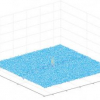Free Online Productivity Tools
i2Speak
i2Symbol
i2OCR
iTex2Img
iWeb2Print
iWeb2Shot
i2Type
iPdf2Split
iPdf2Merge
i2Bopomofo
i2Arabic
i2Style
i2Image
i2PDF
iLatex2Rtf
Sci2ools
ICIP
2006
IEEE
2006
IEEE
End-to-End Delay for Hierarchical B-Pictures and Pulsed Quality Dual Frame Video Coders
Real-time video applications require tight bounds on end-to-end delay. Hierarchical bi-directional prediction requires buffering frames in the encoder input buffer, thereby contributing to encoder input delay. Long-term frame prediction with pulsed quality requires buffering at the encoder output, increasing the output buffer delay. We compare the end-to-end delay of these two approaches using simulations to determine the delay vs. compression efficiency trade-off.
Delay Vs | Encoder Input | End-to-end Delay | ICIP 2006 | Image Processing | Input Delay | Output Buffer Delay |
| Added | 22 Oct 2009 |
| Updated | 27 Oct 2009 |
| Type | Conference |
| Year | 2006 |
| Where | ICIP |
| Authors | Athanasios Leontaris, Pamela C. Cosman |
Comments (0)

